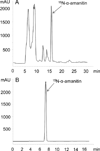Production of (15)N-labeled α-amanitin in Galerina marginata
- PMID: 26100667
- PMCID: PMC4526342
- DOI: 10.1016/j.toxicon.2015.06.018
Production of (15)N-labeled α-amanitin in Galerina marginata
Abstract
α-Amanitin is the major causal constituent of deadly Amanita mushrooms that account for the majority of fatal mushroom poisonings worldwide. It is also an important biochemical tool for the study of its target, RNA polymerase II. The commercial supply of this bicyclic peptide comes from Amanita phalloides, the death cap mushroom, which is collected from the wild. Isotopically labeled amanitin could be useful for clinical and forensic applications, but α-amanitin has not been chemically synthesized and A. phalloides cannot be cultured on artificial medium. Using Galerina marginata, an unrelated saprotrophic mushroom that grows and produces α-amanitin in culture, we describe a method for producing (15)N-labeled α-amanitin using growth media containing (15)N as sole nitrogen source. A key to success was preparing (15)N-enriched yeast extract via a novel method designated "glass bead-assisted maturation." In the presence of the labeled yeast extract and (15)N-NH4Cl, α-amanitin was produced with >97% isotope enrichment. The labeled product was confirmed by HPLC, high-resolution mass spectrometry, and NMR.
Keywords: Amanita; Galerina; Isotope labeling; LC-MS; NMR; α-Amanitin.
Copyright © 2015 Elsevier Ltd. All rights reserved.
Figures





Similar articles
-
Ribosomal biosynthesis of α-amanitin in Galerina marginata.Fungal Genet Biol. 2012 Feb;49(2):123-9. doi: 10.1016/j.fgb.2011.12.005. Epub 2011 Dec 21. Fungal Genet Biol. 2012. PMID: 22202811 Free PMC article.
-
Detection and quantification of Amatoxin in wild mushrooms from North-East India using HPLC-PDA method for food safety purposes.Toxicon. 2024 Nov 28;251:108134. doi: 10.1016/j.toxicon.2024.108134. Epub 2024 Oct 21. Toxicon. 2024. PMID: 39442569
-
Selection and analysis of a DNA aptamer binding α-amanitin from Amanita phalloides.Acta Biochim Pol. 2017;64(3):401-406. doi: 10.18388/abp.2017_1615. Epub 2017 Aug 9. Acta Biochim Pol. 2017. PMID: 28787470
-
Amatoxin-Containing Mushroom Poisonings: Species, Toxidromes, Treatments, and Outcomes.Wilderness Environ Med. 2018 Mar;29(1):111-118. doi: 10.1016/j.wem.2017.10.002. Epub 2018 Jan 8. Wilderness Environ Med. 2018. PMID: 29325729 Review.
-
Mechanism and treatment of α-amanitin poisoning.Arch Toxicol. 2023 Jan;97(1):121-131. doi: 10.1007/s00204-022-03396-x. Epub 2022 Oct 21. Arch Toxicol. 2023. PMID: 36271256 Review.
Cited by
-
Meeting key synthetic challenges in amanitin synthesis with a new cytotoxic analog: 5'-hydroxy-6'-deoxy-amanitin.Chem Sci. 2020 Oct 15;11(43):11927-11935. doi: 10.1039/d0sc04150e. Chem Sci. 2020. PMID: 34094418 Free PMC article.
-
Analysis of α- and β-amanitin in Human Plasma at Subnanogram per Milliliter Levels by Reversed Phase Ultra-High Performance Liquid Chromatography Coupled to Orbitrap Mass Spectrometry.Toxins (Basel). 2020 Oct 23;12(11):671. doi: 10.3390/toxins12110671. Toxins (Basel). 2020. PMID: 33113909 Free PMC article.
-
Detection of α-, β-, and γ-amanitin in urine by LC-MS/MS using 15N10-α-amanitin as the internal standard.Toxicon. 2018 Sep 15;152:71-77. doi: 10.1016/j.toxicon.2018.07.025. Epub 2018 Jul 30. Toxicon. 2018. PMID: 30071219 Free PMC article.
-
Smartphone-based paper microfluidic competitive immunoassay for the detection of α-amanitin from mushrooms.Mikrochim Acta. 2022 Aug 6;189(9):322. doi: 10.1007/s00604-022-05407-1. Mikrochim Acta. 2022. PMID: 35932340
References
-
- Baillie TA. The use of stable isotopes in pharmacological research. Pharmacol. Rev. 1981;33:81–132. - PubMed
-
- Benedict RG, Brady LR. Further studies on fermentative production of toxic cyclopeptides by Galerina marginata (Fr Kühn) Lloydia. 1967;30:372–378.
-
- Enjalbert F, Gallion C, Jehl F, Monteil H, Faulstich H. Simultaneous assay for amatoxins and phallotoxins in Amanita phalloides Fr by high-performance liquid chromatography. J. Chromatogr. 1992;598:227–236. - PubMed
-
- Enjalbert F, Cassanas G, Rapior S, Renault C, Chaumont JP. Amatoxins in wood-rotting Galerina marginata. Mycologia. 2004;96:720–729. - PubMed
Publication types
MeSH terms
Substances
Grants and funding
LinkOut - more resources
Full Text Sources
Other Literature Sources
Miscellaneous

